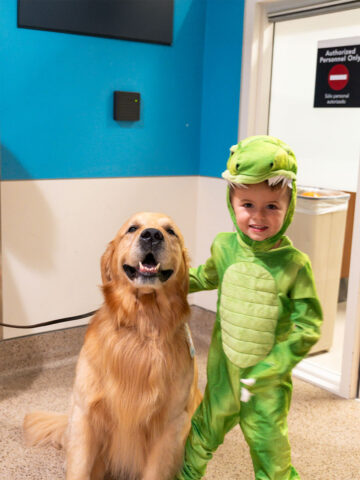Signs, treatment and myths about selective mutism
By Dr. Kristen Yule, CHOC pediatric psychologist
What is selective mutism?
Selective mutism is a rare childhood anxiety disorder where a child cannot speak in certain situations. This often happens in public settings, like at school, or around specific people, such as teachers, peers or extended family members. Children with selective mutism can often communicate in situations or settings where they feel safe and relaxed, like at home with caregivers. The condition is often noticed when a child is around 3 to 4 years of age, but children may not be diagnosed until they begin going to school.
Children with selective mutism may go long periods without speaking at school, which can be mistaken for shyness. This can make it harder to do well in school, interact with others, and keeps them from asking for help or participating in activities that rely on the child speaking, like playdates with peers. Treatment can really help children with selective mutism.
Signs of selective mutism
Signs and symptoms of selective mutism can include:
- A child may feel at ease speaking at home but may be unable to talk in public or around strangers because of anxiety. Struggling with eye contact when feeling uncomfortable.
- A child may use non-verbal communication, such as pointing, writing or head nods/shakes to respond.
- A child might communicate through a trusted individual, such as whispering to a caregiver or friend at school.
Selective mutism often occurs with other anxiety disorders, particularly social anxiety. A diagnosis of selective mutism may be given when speech difficulties continue to occur, making daily functioning more challenging, such as in school or forming friendships due to public speaking challenges. Additional signs may include:
- the inability to speak even to familiar adults in the presence of others;
- difficulty talking with peers in school;
- appearing “shut down” or “paralyzed” when unable to talk; or
- using gestures and facial expressions instead of words to communicate.
Myths about selective mutism
Many times, selective mutism is not recognized, even by professionals like pediatricians, who may mistake it for autism or a communication disorder. Some may think that a quiet child is not speaking because they are being stubborn, but children with selective mutism are actually very anxious and can’t speak even when they want to. Despite depictions in media, selective mutism is not caused by trauma, which tends to affect speech in all situations, not just specific social situations. In addition, the idea that these children will simply outgrow their silence overlooks the intense anxiety they experience. Waiting to act can make the problem worse, causing more emotional and social difficulties and making it harder to treat the issue.
How is selective mutism diagnosed?
If you think your child has selective mutism, get a full evaluation to receive a diagnosis. This assessment should review when your child is verbal and non-verbal and identify any co-existing conditions, like other anxiety disorders. It’s important to rule out other potential causes such as communication disorders. Only experienced professionals can diagnose selective mutism. While its exact cause is not known, selective mutism is sometimes linked to anxiety disorders, shyness and avoidance of speaking situations.
Treatment for selective mutism
Selective mutism responds well to behavioral therapy, which focuses on encouraging speech in many different situations. Treatment should slowly move forward, making sure not to push children too far. Specialized tools will help improve speech and support successful experiences, building confidence for difficult situations. Involvement of everyone in the child’s life is key, as adjusting to the disorder can get in the way of progress. Instead of “rescuing,” caregivers should support coping strategies taught in treatment. While anxiety may not disappear entirely, the child’s ability to manage distress will improve.
Practice speaking is key to treating selective mutism
Children with selective mutism often avoid speaking. When children are not encouraged or required to talk, their avoidance of speaking is then reinforced during daily interactions. Treatment can help break this pattern by providing opportunities for children to speak in anxiety-inducing situations. Since children spend more time at home than in therapy sessions, caregivers play a major role. Clinicians should educate caregivers on how to support and boost the skills learned in therapy, encouraging speech, and promoting positive speaking experiences whenever possible.
Working with the school when navigating selective mutism
In a complete treatment plan, it’s important to involve the child’s school. Educators might lack awareness of selective mutism, mistaking silence for other issues like comprehension difficulties or defiance. Like caregivers, teachers may accidentally adapt to the silence, which can prevent progress. Educators can be trained to understand and support children with selective mutism with guidance from the child’s clinician. Collaboration between clinicians and teachers, such as through training and specific tools, is key.
Children with selective mutism may also qualify for accommodations or special services under Section 504 or an Individualized Education Plan (IEP). An IEP is a personalized plan designed to support students with a variety of different disabilities and challenges at school. For children with selective mutism, an IEP can provide specific accommodations to help them overcome communication issues in the classroom, such as using other forms of communication, gradual exposure tools, and support environments to boost verbal communication. These plans, in turn, help to ensure that children get the support they need to do well in school and with peer relationships.
Tips for helping kids with selective mutism talk
- Allow a 5-second pause: Instead of rushing, wait for 5 seconds after asking a question to allow children time to respond. This can boost their ability to manage their anxiety.
- Use specifically labeled praise: Instead of general praise (“Good job!), be specific about the behavior that you are celebrating (“Great job using your words to tell me what you want!”) to support positive actions and motivate continued progress.
- Avoid yes/no questions: Instead, use open-ended questions (“What did you do at school today?”) or forced-choice questions (“Do you want milk or juice?”) to encourage talking and provide more speaking opportunities.
- Practice echoing: Repeat or translate what the child says to support understanding and encourage participation; this is especially useful for quieter speakers.
- Be a sportscaster: Describing the child’s actions to show interest and engagement (“You are drawing a flower.”) can be helpful when the child is nonverbal.
Helpful links and resources for navigating selective mutism
- Child Mind Institute Selective Mutism Program: The Child Mind Institute has a full treatment program that offers individualized, evidence-based behavioral interventions, including the intensive group treatment program Brave Buddies℠.
- Selective Mutism Group: A national organization that can help you find a treatment provider in your area.
- Selective Mutism Association – Toolkit for Caregivers: The Selective Mutism Association created a helpful, free downloadable guide for caregivers of youth with selective mutism.
- Kurtz Psychology – Selective Mutism Learning University: Selective Mutism Learning University is the free web course designed by the Selective Mutism team at Kurtz Psychology Consulting PC for parents, caregivers, teachers, therapists and all concerned professionals with the skills needed to help children with selective mutism.





